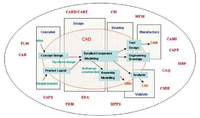Computer-aided technologies

Hey there kiddo! Today, I'll teach you about computer-aided technologies. So imagine you're drawing a picture, but instead of using pencils, colors and paper, you're drawing it on a computer. That's called computer-aided design or CAD.
But the computer can help with a lot more than just drawing pictures. For example, imagine you want to know how a car will perform before it's even built. Instead of building it and testing it out, engineers can use computer-aided engineering (CAE) to simulate how the car will behave in different situations, which saves a lot of time and money.
Now, let's say you have a fancy machine you want to make, but you're not sure how it will work in the real world. Computer-aided manufacturing (CAM) can help you create a virtual version of the machine that you can test and tweak before you create it in real life. This also saves time and money, and helps ensure that the machine will work properly once it's made.
Finally, let's talk about computer-aided medicine. This might sound a little scary, but it's actually pretty cool. Doctors can use computer-aided technologies to help them diagnose diseases and plan surgeries. For example, MRI and CT scans create 3D images of the body that doctors can use to plan surgeries.
So, in summary, computer-aided technologies are ways to use computers to help us design, test, and create things like cars, machines, and even medical procedures. It saves us time and money, and helps ensure that the things we make will work properly.
But the computer can help with a lot more than just drawing pictures. For example, imagine you want to know how a car will perform before it's even built. Instead of building it and testing it out, engineers can use computer-aided engineering (CAE) to simulate how the car will behave in different situations, which saves a lot of time and money.
Now, let's say you have a fancy machine you want to make, but you're not sure how it will work in the real world. Computer-aided manufacturing (CAM) can help you create a virtual version of the machine that you can test and tweak before you create it in real life. This also saves time and money, and helps ensure that the machine will work properly once it's made.
Finally, let's talk about computer-aided medicine. This might sound a little scary, but it's actually pretty cool. Doctors can use computer-aided technologies to help them diagnose diseases and plan surgeries. For example, MRI and CT scans create 3D images of the body that doctors can use to plan surgeries.
So, in summary, computer-aided technologies are ways to use computers to help us design, test, and create things like cars, machines, and even medical procedures. It saves us time and money, and helps ensure that the things we make will work properly.
